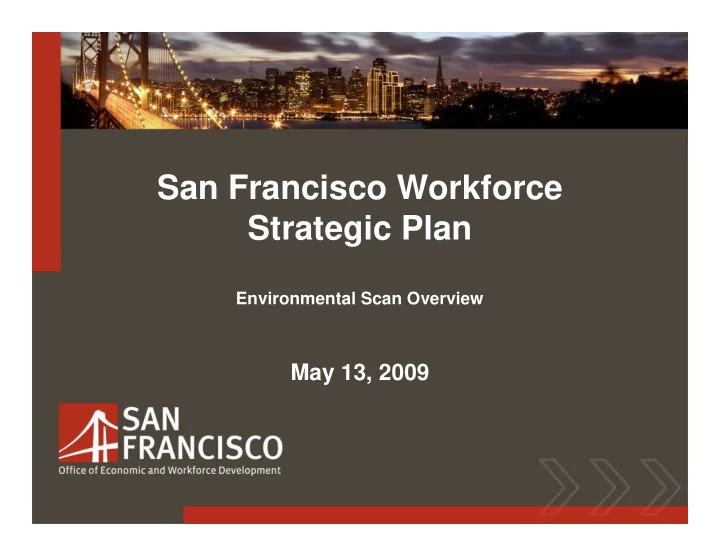

San Francisco Workforce Strategic Plan Environmental Scan Overview May 13, 2009
Overview of Conditions 1. Economy Structure: � Four Key Segments : Knowledge, Experience, Human Infrastructure, Physical Infrastructure � Seven Priority Industries : Biotechnology, Construction, Health Care, Hospitality, Information Technology/Digital Media Retail, Transportation 2. Disparate growth at high and low end of labor market 3. Concentrated pockets of need in many areas of San Francisco 2
Scope of Workforce Services • $71.8 million in public monies being invested into SF’s WFD system (only $12m in WIA) • 294 workforce service providers 198 CBOs 40 union apprenticeship programs 27 gov’t agencies, 29 post-secondary educational institutions 3
Findings 1. The workforce system lacks the appropriate oversight, strategic priorities, policy and administration 2. Workforce system cannot quickly adapt to the dynamic economic trends that influence the city’s labor market 3. Workforce and education programs are not closely linked with real career opportunities, career ladders or advancement 4. Workforce services not effectively serve youth, particularly transition age youth 5. A disconnect exists between what customers expect and what the workforce system provides 6. Few employers and residents know about the workforce systems and/or have an unfavorable perception of the quality of services 4
Finding 1 “The workforce system lacks the appropriate oversight, strategic priorities, policy and administration” • $78.1 million spent by 22 government agencies and foundations each with • Disparate performance outcomes and measurement, need stronger alignment across agencies • Disconnect between WF & education • Need centralization of employment services, administration of and local hiring ordinances 5
Finding 2 “Workforce system cannot quickly adapt to the dynamic economic trends that influence the city’s labor market” • Jobs are disproportionately growing at high end of the labor market • Residents feel that high paid jobs are out of their reach • Many workforce providers express interest in targeting key sectors, but indicate they lack an understanding to effectively serve them • Tax credits and other workforce services are not maximized to attract, retain and grow businesses 6
Finding 3 “Workforce and education programs are not closely linked with real career opportunities, career ladders or advancement” • Employers, job seekers and training providers each have different expectations for job training and skills needed for success • Employers already invest heavily in training in house or through external training providers • Workforce services are too heavily focused on helping job seekers find their first job. Very few focus on career advancement or incumbent worker training • Job seekers and employers said that a clearly articulated career path with advancement opportunities is the most effective tool to retain workers 7
Finding 4 “Workforce services not effectively serve youth, particularly transition aged youth” • Youth workforce services are difficult to find and navigate • Difficult to maintain service continuity as youth transition to adulthood because of funding requirements • Workforce providers indicated that programs that have real world and hands on experience such as apprenticeship programs and Bridges to Bio Tech are most effective • Severe gaps exist within the workforce infrastructure. One stops are not “youth-friendly” • Many young job seekers have severe basic skills deficiencies, workforce programs must focus more closely on basic skills • Many youth face other barriers such as housing, mental health issues and substance abuse, but do not know where to get help 8
Finding 5 “Workforce and education programs are not closely linked with real career opportunities, career ladders or advancement” • Employers, job seekers and training providers each have different expectations for job training and skills needed for success • Employers already invest heavily in training in house or through external training providers • Workforce services are too heavily focused on helping job seekers find their first job. Very few focus on career advancement or incumbent worker training • Job seekers and employers said that a clearly articulated career path with advancement opportunities is the most effective tool to retain workers 9
Finding 6 “Few employers and residents know about the workforce systems and/or have an unfavorable perception of the quality of services” • Few employers and residents choose to use workforce services provided by the City • Employers and residents perceive that the workforce system cannot meet their needs and is difficult to use • Youth perceive workforce services as inaccessible or not “youth friendly” • Residents noted a lack of information and outreach about workforce resources available • Service providers see the need to convene and share best practices and information about trends in workforce development 10
Recommend
More recommend